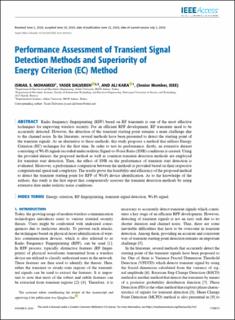| dc.contributor.author | Ismail S., Mohamed | |
| dc.contributor.author | Dalveren, Yaser | |
| dc.contributor.author | Kara, Ali | |
| dc.date.accessioned | 2020-09-07T07:07:39Z | |
| dc.date.available | 2020-09-07T07:07:39Z | |
| dc.date.created | 2020-06-26T14:23:12Z | |
| dc.date.issued | 2020 | |
| dc.identifier.issn | 2169-3536 | |
| dc.identifier.uri | https://hdl.handle.net/11250/2676520 | |
| dc.description.abstract | Radio frequency fingerprinting (RFF) based on RF transients is one of the most effective techniques for improving wireless security. For an efficient RFF development, RF transients need to be accurately detected. However, the detection of the transient starting point remains a main challenge due to the channel noise. In the literature, several methods have been presented to detect the starting point of the transient signals. As an alternative to these methods, this study proposes a method that utilizes Energy Criterion (EC) technique for the first time. In order to test its performance, firstly, an extensive dataset consisting of Wi-Fi signals recorded under realistic Signal-to-Noise Ratio (SNR) conditions is created. Using the provided dataset, the proposed method as well as common transient detection methods are employed for transient start detection. Then, the effect of SNR on the performance of transient start detection is evaluated. Moreover, a performance comparison between the methods is provided based on their respective computational speed and complexity. The results prove the feasibility and efficiency of the proposed method to detect the transient starting point for RFF of Wi-Fi device identification. As to the knowledge of the authors, this study is the first report that comparatively assesses the transient detection methods by using extensive data under realistic noise conditions. | en_US |
| dc.language.iso | eng | en_US |
| dc.publisher | Institute of Electrical and Electronics Engineers (IEEE) | en_US |
| dc.rights | Navngivelse 4.0 Internasjonal | * |
| dc.rights.uri | http://creativecommons.org/licenses/by/4.0/deed.no | * |
| dc.title | Performance Assessment of Transient Signal Detection Methods and Superiority of Energy Criterion (EC) Method | en_US |
| dc.type | Peer reviewed | en_US |
| dc.type | Journal article | en_US |
| dc.description.version | publishedVersion | en_US |
| dc.source.journal | IEEE Access | en_US |
| dc.identifier.doi | 10.1109/ACCESS.2020.3004492 | |
| dc.identifier.cristin | 1817320 | |
| dc.description.localcode | This work is licensed under a Creative Commons Attribution 4.0 License. For more information, see https://creativecommons.org/licenses/by/4.0/ 115613 | en_US |
| cristin.ispublished | true | |
| cristin.fulltext | postprint | |
| cristin.fulltext | original | |
| cristin.qualitycode | 1 | |

